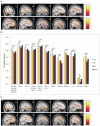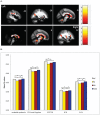Neurobiological Commonalities and Distinctions Among Three Major Psychiatric Diagnostic Categories: A Structural MRI Study
- PMID: 29036668
- PMCID: PMC5768040
- DOI: 10.1093/schbul/sbx028
Neurobiological Commonalities and Distinctions Among Three Major Psychiatric Diagnostic Categories: A Structural MRI Study
Abstract
Background: Schizophrenia (SZ), bipolar disorder (BD), and major depressive disorder (MDD) are distinct diagnostic categories in current psychiatric nosology, yet there is increasing evidence for shared clinical and biological features in these disorders. No previous studies have examined brain structural features concurrently in these 3 disorders. The aim of this study was to identify the extent of shared and distinct brain alterations in SZ, BD, and MDD. We examined gray matter (GM) volume and white matter (WM) integrity in a total of 485 individuals (135 with SZ, 86 with BD, 108 with MDD, and 156 healthy controls [HC]) who underwent high-resolution structural magnetic resonance imaging (MRI) and diffusion tensor imaging (DTI) at a single site.
Results: Significant 4-group (SZ, BD, MDD, and HC groups) differences (P < .05, corrected) in GM volumes were found primarily in the paralimbic and heteromodal corticies. Post hoc analyses showed that the SZ, BD, and MDD groups shared GM volume decreases in 87.9% of the total regional volume with significant 4-group differences. Significant 4-group differences in WM integrity (P < .05 corrected) were found in callosal, limbic-paralimbic-hetermodal, cortico-cortical, thalamocortical and cerebellar WM. Post hoc analyses revealed that the SZ and BD groups shared WM alterations in all regions, while WM alterations were not observed with MDD.
Conclusions: Our findings of common alterations in SZ, BD, and MDD support the presence of core neurobiological disruptions in these disorders and suggest that neural structural distinctions between these disorders may be less prominent than initially postulated, particularly between SZ and BD.
Keywords: bipolar disorder; gray matter volume; major depressive disorder; schizophrenia; white matter integrity.
© The Author(s) 2017. Published by Oxford University Press on behalf of the Maryland Psychiatric Research Center. All rights reserved. For permissions, please email: journals.permissions@oup.com.
Figures


References
-
- Kraepelin E. Manifestation of insanity. Z Gesamte Neurol Psychiatr. 1920;62:1–29.
-
- Rosen C, Marvin R, Reilly JL et al. . Phenomenology of first-episode psychosis in schizophrenia, bipolar disorder, and unipolar depression: a comparative analysis. Clin Schizophr Relat Psychoses. 2012;6:145–151. - PubMed
-
- Häfner H, Maurer K, Trendler G, an der Heiden W, Schmidt M, Könnecke R. Schizophrenia and depression: challenging the paradigm of two separate diseases–a controlled study of schizophrenia, depression and healthy controls. Schizophr Res. 2005;77:11–24. - PubMed
Publication types
MeSH terms
Grants and funding
LinkOut - more resources
Full Text Sources
Other Literature Sources
Medical

